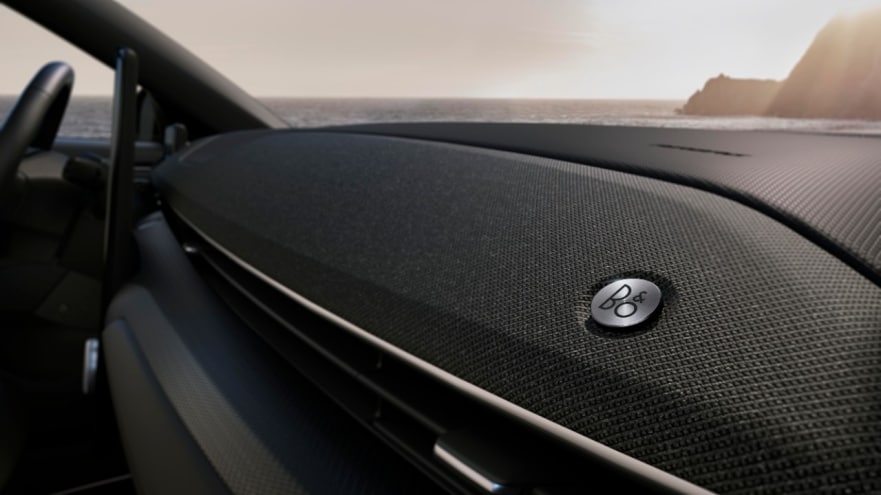A growing desire for a premium audio experience in vehicles1 and the emerging trend for creating a more domestic feeling environment in electrified vehicles has been integral to the award-winning design2 of all-new, all-electric Mustang Mach-E’s B&O Sound System.
Ford’s human-centric design philosophy and the fact drivers spend an average of four years of their life behind the wheel3 also contribute to the unique design, which sees one third of its dashboard dominated by the audio. It’s the first Ford vehicle to give its audio system such prominence.
The specially developed Heathered Grey textile that conceals the dashboard-mounted tweeters replicates the look and feel of the fabric-based speaker covers of B&O’s iconic home speakers, yet is robust enough for use in a vehicle.
This not only gives all occupants of the Mustang Mach-E, including passengers both front and rear, a great audio experience and makes a significant style statement, it also helps to create an element of calmness. For drivers it makes being behind the steering wheel an even more compelling place to be.
Audio system
 An Externally Coupled Subwoofer (ECS) also uses the cabin’s unique shape to produce powerful bass performance, despite being around half the weight of a traditional subwoofer and taking up around 80 per cent less space. The weight-saving is just one of the measures Ford has taken to help Mustang Mach-E achieve a targeted WLTP driving range of up to 600 km (more than 370 miles) in rear-wheel drive configuration.4
An Externally Coupled Subwoofer (ECS) also uses the cabin’s unique shape to produce powerful bass performance, despite being around half the weight of a traditional subwoofer and taking up around 80 per cent less space. The weight-saving is just one of the measures Ford has taken to help Mustang Mach-E achieve a targeted WLTP driving range of up to 600 km (more than 370 miles) in rear-wheel drive configuration.4
Drawing inspiration from the B&O sound experience in the Mustang, HARMAN acoustic engineers re-examined the acoustic characteristic of the Mustang system to craft a similar aural experience. Electric vehicles are inherently quieter thanks to a lack of noise from a traditional internal combustion engine, however this does reveal new sources of noise that are usually muffled. This was something the engineers overcame while leveraging the opportunities of a quiet EV cabin – preserving rich bass performance and maintaining the clarity and detail true to the artist’s intent.
Spoken voice
 The tuning also makes the most of the spoken voice, which helps audio books to be more immersive, gives phone calls extra clarity and, with the growing trend of drive-in cinemas, can even convey the rich range of sounds in movies with high quality. Mach-E’s infotainment system even has integrated apps for podcasts – unlike some rivals – and is able to play them with optimum performance through the audio.
The tuning also makes the most of the spoken voice, which helps audio books to be more immersive, gives phone calls extra clarity and, with the growing trend of drive-in cinemas, can even convey the rich range of sounds in movies with high quality. Mach-E’s infotainment system even has integrated apps for podcasts – unlike some rivals – and is able to play them with optimum performance through the audio.
Additional technology
 The Mach-E is geared-up for the future with over-the-air updates that allows the vehicle to stay at the forefront of technology without the owner having to leave home. Nearly all Mach-E computer modules can be updated wirelessly, meaning Ford can deliver performance enhancements and entirely new features that might not exist when customers first take delivery of their vehicles.
The Mach-E is geared-up for the future with over-the-air updates that allows the vehicle to stay at the forefront of technology without the owner having to leave home. Nearly all Mach-E computer modules can be updated wirelessly, meaning Ford can deliver performance enhancements and entirely new features that might not exist when customers first take delivery of their vehicles.
The all-electric Mustang Mach-E spearheads a rapidly expanding Ford electrified vehicle range and is one of 18 new electrified vehicles the company is introducing to Europe before the end of 2021.
Quotes
 “Human-centric design is about focusing on all the senses. Sound is an integral part of peoples’ lives and has become an integral part of our design too, whether it’s for practical business communication or the goosebumps stimulated by musical experiences.”
“Human-centric design is about focusing on all the senses. Sound is an integral part of peoples’ lives and has become an integral part of our design too, whether it’s for practical business communication or the goosebumps stimulated by musical experiences.”
Amko Leenarts, design director, Ford of Europe
“Listening to music can positively impact mood. A premium sound system can not only increase the enjoyment of the vehicle, but studies show it can even help drivers to focus, particularly on long monotonous roads5.” Brandon Wheeler, Harman Sr. Manager of Acoustics for Ford/ Lincoln
Links
https://news.ihsmarkit.com/prviewer/release_only/slug/premium-audio-remains-important-consumers-new-vehicle-purchase-decisions-ihs-markit-su
2iF DESIGN AWARD 2020 in the product discipline
3 https://www.webuyanycar.com/about-us/press-centre/drive-of-a-lifetime/
4The declared fuel/energy consumptions, CO2-emissions and electric range are determined according to the technical requirements and specifications of the European Regulations (EC) 715/2007 and (EU) 2017/1151 as last amended. Light Duty Vehicle type-approved using the World Harmonised Light Vehicle Test Procedure (WLTP) will have fuel/energy consumption and CO2-emission information for New European Drive Cycle (NEDC) and WLTP. WLTP will fully replace the NEDC latest by the end of the year 2020. The applied standard test procedures enable comparison between different vehicle types and different manufacturers. During NEDC phase-out, WLTP fuel consumption and CO2 emissions are being correlated back to NEDC. There will be some variance to the previous fuel economy and emissions as some elements of the tests have altered, so the same car might have different fuel consumption and CO2 emissions.
5 https://www.sciencedaily.com/releases/2013/06/130606101550.htm

